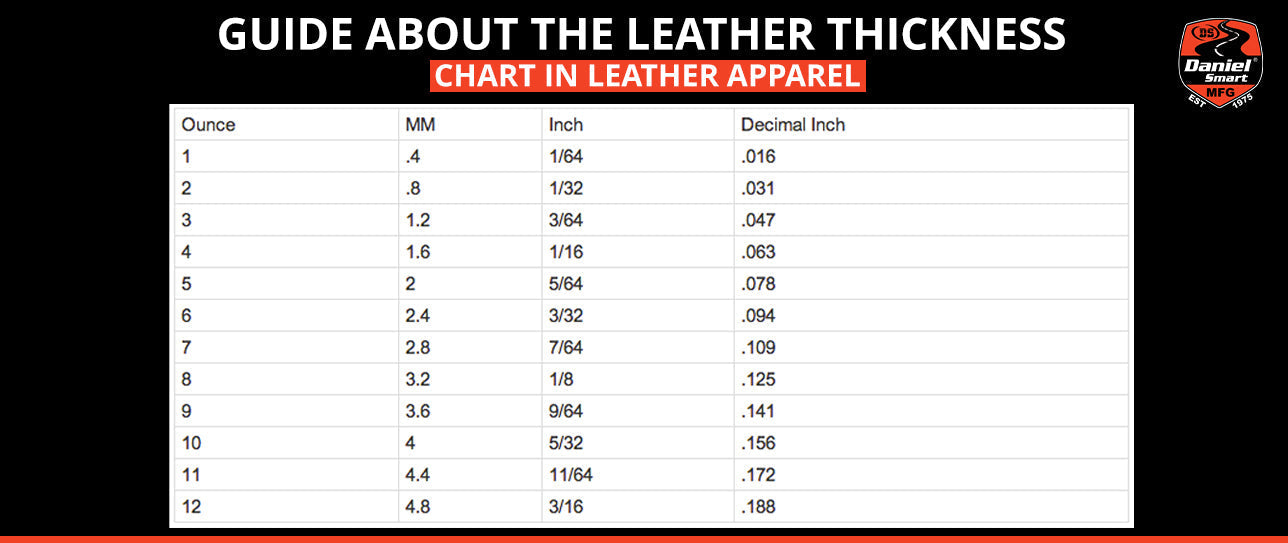Have you wondered about the thickness of the Leather jackets, Vest, and Chaps? How are these classical and Elegant Pieces crafted with Genuine leather? How do manufacturers choose the thickness of their leather jackets?
Today, we will discuss about the leather thickness chart and leather weight. Start your ride with us to learn more about this.
Key points we will cover in this blog:
The following are the important points we will cover in the information and helpful blog post:
- Guide about the Leather Thickness by an Experience Leather maker
- What to know about the Leather weight?
- Process of measuring Leather thickness
- Difference between the Scales like Company scale and standard Scale
- Thickness suitable for every category like Jackets, Vest, Chaps, gloves and working gloves and luggage and Boots
Leather Thickness by an Experience Leather Manufacturer:
Regarding leather, the thickness greatly influences its feel, performance, and lifetime over which it holds itself. As a leather maker, we can say that our clients personally understand the need of selecting the correct thickness for their gear.
The thickness of the leather influences everything from comfort to durability whether you're choosing vests, Jackets, or motorcycle chaps.
Usually expressed in ounces, leather thickness is 1/64th of an inch each ounce represents. A 2-ounce leather, for instance, is roughly 1/32' thick; a 6-ounce leather would be roughly 3/32' thick.
For heavier clothing like motorcycle jackets and chaps, thicker leather—around 7–8 ounces—offers superior protection and wear resistance. You might have to break it in though, it feels a bit stiffer.
Conversely, thinner jackets or wallets usually call for lighter leather, about 3-4 ounces, which is more flexible and pleasant. It's ideal for everyday wear but provides less defense in tough environments.
As a manufacturer, our constant goal is to strike the ideal thickness for your requirements, thereby offering a strong feel without compromising comfort.
The secret is to pick leather for jackets that fit your style and the intended use for the gear. A correctly selected leather thickness will feel like a second skin and survive through every adventure.
What to know about the Leather Weight?

Leather weight gives information about how heavy or bulky your final product is. A leather jacket is thick, and the leather is measured in ounces per square foot. The weight of the leather determines its strength, flexibility, and use cases.
Lighter Leather Usually used for wallets, gloves, and small accessories, light leather—which weights between one ounce and three ounces—is supple, flexible. Though it gives comfort and is easy to work with, it lacks the durability required for protective clothing.
About 4 ounces to 6 ounces, medium-weight leather finds a mix between comfort and durability. Offering both flexibility and enough protection for daily usage, it's employed for vests, jackets, and basic leather products.
Used for high-durability goods such as motorcycle gear, saddlebags, and work belts, heavy leather—which is 7 ounces and above—is thick and solid. Although it offers the best protection, initially, it may feel stiff and take time to break in.
Choosing the right leather weight is key to ensuring your product is both functional and comfortable for its intended purpose. Whether you need flexibility or strength, the weight of the leather should align with how the item will be used.
Process of measuring Leather thickness:

In leatherworking, measuring leather thickness is important because it tells you how the material will work in different situations.
Using a Gauge for thickness:

Tool: A leather thickness gauge, known as a caliper, is commonly used for accurate measurements. This tool pinches the leather gently to show its thickness in ounces or millimeters.
Method: Place the gauge on the edge of the leather piece and gently close it until it touches both sides of the leather. The gauge will display the thickness reading.
Reading: Leather thickness is usually expressed in a range (e.g., 4-5 oz) since natural leather can vary slightly within a single piece.
Using a Ruler and Eye Estimate:

For smaller, informal projects, some artisans rely on experience and a ruler, estimating based on known thicknesses. This method is less precise but can work in a pinch for minor projects.
Conversion of Ounces to Millimeters:

If you work overseas, you might have to translate ounces into millimeters. One ounce is around 0.4 millimeters. Hence, a five-ounce of leather would be roughly two millimeters thick.
Measuring leather thickness is straightforward with the right tools, ensuring your leather suits your project's specific needs in both flexibility and durability.
Difference between the Scales like Company scale and standard Scale:
In leather measurement, scales can vary depending on the region or company producing or selling the leather. Here's how the company scale and standard scale differ:
Standard Scale (Ounce System):

This scale is the most widely recognized system, especially in the USA. Leather thickness is measured in ounces. This standard helps to easily communicate thickness across the industry. It is commonly used in leatherworking guides and product specifications, ensuring consistency.
Company Scale:
Some leather suppliers use their own internal scales or range estimations, which can differ slightly from the standard scale. For example, they might label their leather "lightweight," "medium weight," or “heavyweight" based on their internal classifications rather than exact ounce or millimeter measurements.
Certain companies may also use a range rather than an exact measurement, like "4-5 oz,” rather than a precise single thickness.
Company scales can be beneficial for providing customers a quick sense of the leather's intended use (e.g., lightweight for gloves vs. heavyweight for saddlebags) but may lack the precision of the standard scale.
How to Differentiate between them:
If you're buying leather, checking both the company's description and the standard thickness in ounces or millimeters can help you make an informed choice. This way, you can compare leather weights accurately across suppliers and projects, regardless of scale differences.
Leather Thickness Chart - Thickness Suitable for Different Categories:
Here are some authentic thicknesses for the different categories of leather products, such as leather for jackets, vests, chaps, gloves, boots, and luggage. Leather thickness recommendations for each type of product, based on durability and comfort needs:
Leather Jackets Thickness:

Thickness: 3 oz to 4 oz (1.2 mm to 1.6 mm) thick leather jacket
Reason: This thickness of the thick leather jacket offers a nice mix of sturdiness and flexibility, which lets the jacket fit comfortably and shields it from the elements.
Leather Vests Thickness:

Thickness: 2 oz to 3 oz (0.8 mm to 1.2 mm)
Reason: Particularly for layering over other garments, vests must be flexible and light-weight. This thinner leather retains vest comfort without adding weight.
Chaps Thickness:

Thickness: 4 oz to 5 oz (1.6 mm to 2.0 mm)
Reason: Chaps require a bit more thickness for added protection while riding. This thickness guards against abrasions and adds durability for outdoor use.
Fashion Gloves Thickness:

Thickness: 1 oz to 2 oz (0.4 mm to 0.8 mm)
Reason: Fashion gloves must be flexible and comfortable from thin, soft leather that lets you move easily and provides great tactile feel.
Leather Luggage and Bags Thickness:

Thickness: 5 oz to 6 oz (2.0 mm to 2.4 mm)
Reason: Luggage and bags require a stronger leather to manage weight and resist stretching. This thicker leather gives structural stability and longevity.
Leather Boots:
Thickness: 5 oz to 7 oz (2.0 mm to 2.8 mm)
Reason: For riding or any other heavy-duty boots that withstand tough conditions, these pieces need strong leather to offer protection, support, and a lifetime.
You must review the leather weight chart before Selecting the appropriate thickness for every category. It is essential to provide durable, comfortable goods fit for their intended usage.
Final Remarks:
Leather thickness is measured by weight, not in standard ruler terms like mm. now you will understand the leather thickness chart confidently. Understanding this relationship helps in selecting the perfect leather thickness for your next purchase, balancing durability and comfort, and your leather product will meet both practical and aesthetic needs.


